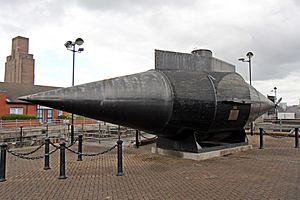Resurgam facts for kids
The Resurgam (which means "I shall rise again" in Latin) was an early Victorian submarine. It was designed and built in Britain by a man named Reverend George Garrett. He wanted to create a weapon that could get past the strong chain nets used to protect ships from torpedo attacks.
Contents
The First Resurgam Submarine
The very first Resurgam was built in 1878. It was a small submarine, only about 5 meters (14 feet) long. It was powered by hand and could only hold one person. Because of its unique shape, it was sometimes called "the curate's egg". This first submarine was a smaller test version of Garrett's bigger design.
The Second Resurgam Submarine
Building the Submarine
The second Resurgam was built by a company called Cochran & Co. in Birkenhead, England. It was launched on November 26, 1879. The submarine was made from iron plates attached to iron frames. The middle part of the vessel was covered with wood and held in place by iron straps.
When it was finished, the Resurgam was about 13.7 meters (45 feet) long and 3 meters (10 feet) wide. It weighed about 30 metric tons (30 long tons) and had a crew of three people. It was powered by a special steam engine that could make enough steam to turn its propeller for up to four hours. This engine was first invented by an American engineer named Emile Lamm in 1872.
The submarine was designed to float easily (have positive buoyancy). To dive underwater, it used two special fins called hydroplanes located in the middle of the vessel. Building this submarine cost £1,538, which was a lot of money back then.
After successful tests in the East Float at Wallasey, the plan was for Resurgam to travel by itself from Birkenhead to Portsmouth. There, it would be shown to the Royal Navy.
How the Resurgam Was Lost
On December 10, 1879, the Resurgam began its journey to Portsmouth. The crew included Garrett, Jackson (the skipper), and Price (the engineer). However, they ran into mechanical problems and had to stop at Foryd Harbour in Rhyl for repairs.
After the repairs were done and more tests were completed, the crew set sail again on the night of February 24, 1880. It was a very windy night. The Resurgam was being towed by a steam yacht called Elphin, which Garrett had bought to help the submarine.
During the journey, the Elphin started having engine trouble. The crew of the Resurgam went onto the Elphin to help fix it. Unfortunately, the entry hatch on the Resurgam could not be closed from the outside. This meant water started to get into the submarine. Because of the extra weight from the water, the tow-rope broke. The Resurgam sank in Liverpool Bay off Rhyl on February 25, 1880.
Finding the Wreck
For many years, no one knew exactly where the Resurgam had sunk. But in 1995, an experienced diver named Keith Hurley found it. He was trying to clear tangled fishing nets in about 18 meters (60 feet) of water.
On July 4, 1996, the Resurgam wreck was given special protection under the Protection of Wrecks Act. This means it is an important historical site. The wreck is located at 53°23.78′N 03°33.18′W / 53.39633°N 3.55300°W.
The Resurgam's hull (the main body of the submarine) is still mostly in one piece, even though it has some damage. It is still at risk from illegal diving and fishing trawlers. Since it was found, parts like the steering wheel have been broken, and some smaller items have gone missing.
In 1997, a project called SUBMAP started to study the wreck site. More than a hundred volunteer divers helped survey the submarine's structure and the sea life around it. They used special equipment to search for other items nearby. The results of this project were saved as a detailed digital record.
To protect the wreck from rusting further, special metal pieces called sacrificial anodes have been attached to the hull. These pieces rust instead of the submarine. There have been ideas to raise the Resurgam from the sea, but so far, this has not happened.
The Resurgam was shown on a TV show called Wreck Detectives in 2004. In 2007 and again in 2012, divers from the British Sub-Aqua Club helped with conservation work by replacing the sacrificial anodes on the wreck.
Replica of the Resurgam
A copy of the Resurgam was built by students at the AMARC Training College in Birkenhead between 1996 and 1997. This replica was put on display at Woodside Ferry Terminal in Birkenhead in March 1997.
After some time, the replica started to show wear and tear. In 2009, students from the North West Maritime and Engineering College helped fix it up and make it look new again.
Images for kids




